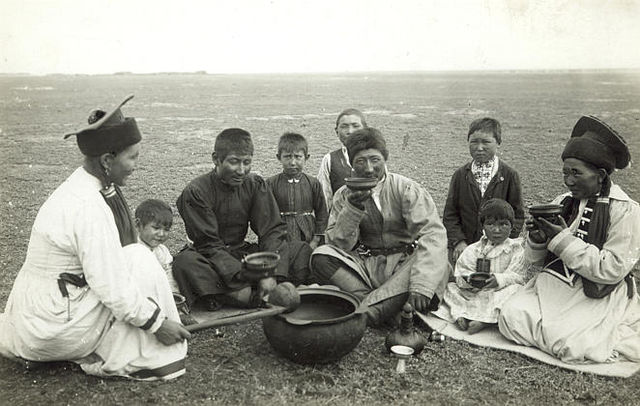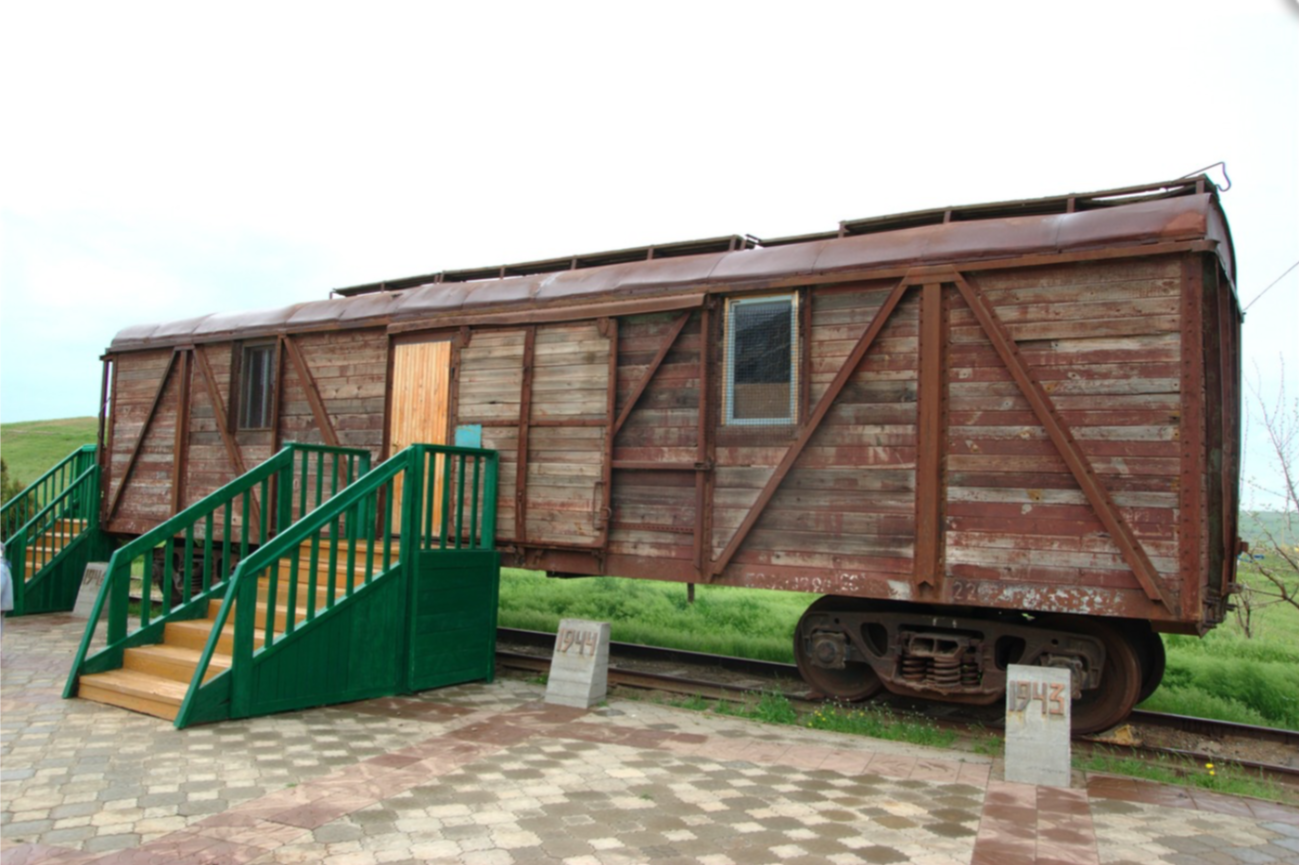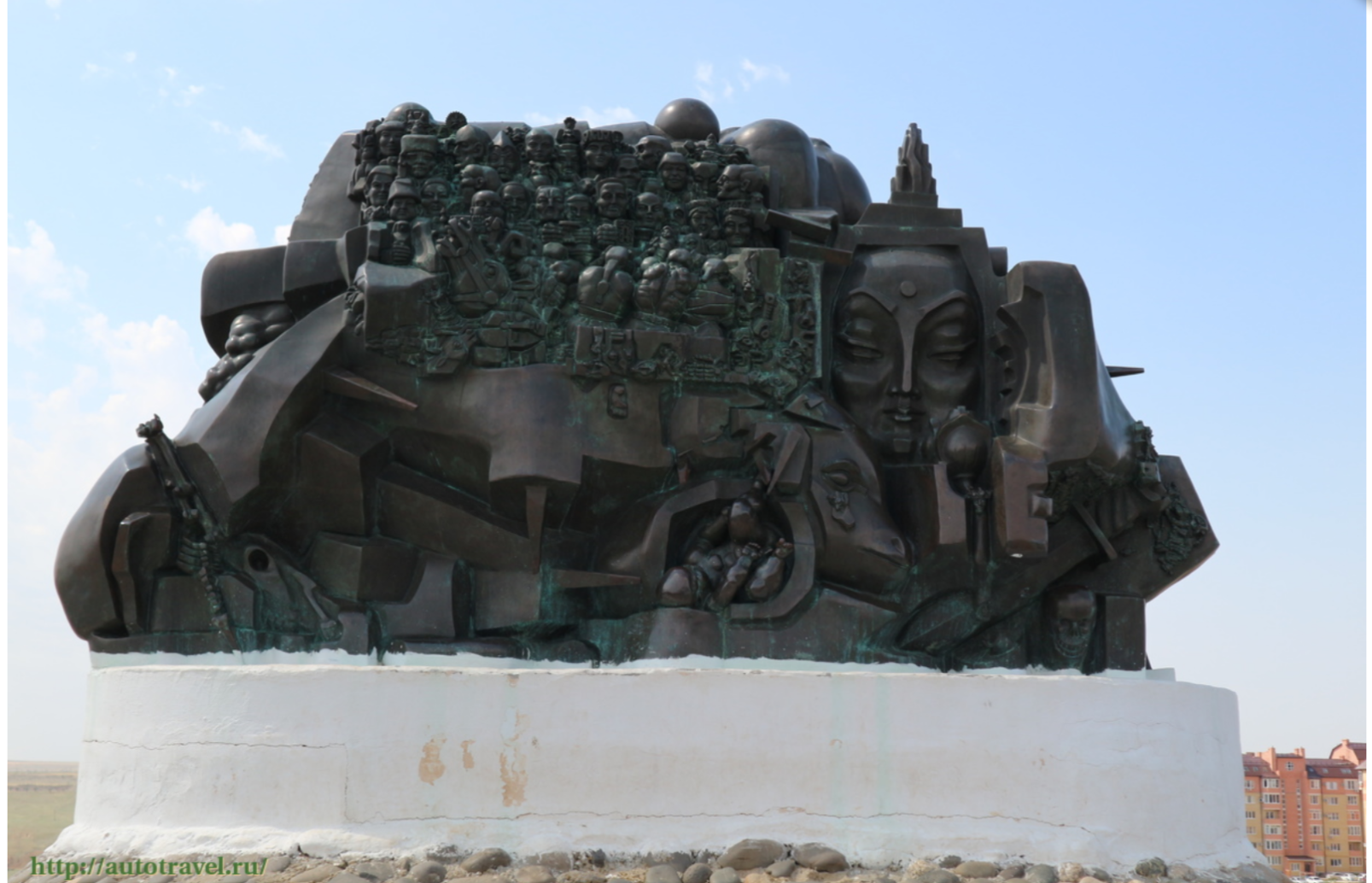Deportation of Kalmyks in 1943
On 28 December 1943, Operation Ulusi began — a mass deportation of the Kalmyk population. In just one day, the Soviet authorities forcibly gathered and dispatched tens of thousands of people from their native lands to Siberia and Central Asia. They were transported in cattle cars designed for livestock, without adequate living conditions. By mid-1944, the total number of deportees had reached around 120,000, including both civilian residents of Kalmykia and military personnel who were removed from the front and classified as “special settlers”.
Project Erased histories is supported by the European Union under the House of Europe programme.
Alongside the deportation, the Soviet authorities decided to liquidate the Kalmyk Autonomous Republic. Its administrative units were absorbed into neighbouring regions, with part incorporated into the newly formed Astrakhan Oblast. For decades, the Kalmyks lost not only their homeland but also their national autonomy. Only after the 20th Congress of the Communist Party of the Soviet Union in 1956 were restrictions lifted, and in 1957 a gradual process of return and restoration of autonomy began.
This article examines the events that led to the deportation, its scale, mechanisms, and consequences.
Who are the Kalmyks?
The Kalmyks are one of the few peoples who introduced steppe nomadic culture and Buddhism to Europe. Their ancestors were the Oirats, nomadic tribes from Central Asia who migrated to the Caspian region in the 17th century, settling between the Volga and Don rivers. The Kalmyk Khanate, formed in this territory, preserved its political system, language, religion, and way of life.

Kalmyks drinking tea in the steppe of Salsky District, Don Host Oblast, Russia. Late 19th century. Source: Wikipedia
The Kalmyk language belongs to the Mongolic group, and their traditional religion is Tibetan Buddhism. From the 17th to the early 20th century, the Kalmyks retained elements of autonomy but gradually lost political independence within the Russian Empire and later the USSR. According to the 1939 All-Union Census, the population of the Kalmyk ASSR was 220,689.
At the beginning of the 20th century, the Kalmyks became entangled in Soviet national policy: initially as an ethnic group granted autonomy, later as an “unreliable population” targeted by resettlement policies.
Reasons for the deportation
- Accusations of collaboration with the occupiers. After the liberation of Kalmykia from German forces, the Soviet authorities accused the population of mass collaboration with the Nazis. Claims included joining German-led armed formations, betraying Soviet citizens, and helping transport livestock. These accusations became the official justification for repressions, though many were exaggerated or unsubstantiated.
- The myth of the Kalmyk Division’s “betrayal”. Soviet propaganda spread the claim that the 110th Kalmyk Cavalry Division had almost entirely defected or surrendered. In fact, most soldiers perished in defensive battles. After heavy losses, the division was disbanded, with survivors transferred to other units. Nevertheless, stories of betrayal were used to justify the deportation of the entire population.
- Accusations of anti-Soviet activities after liberation. The Decree of the Presidium of the Supreme Soviet alleged that some Kalmyks organised armed groups, attacked collective farms, resisted the authorities, and intimidated locals. Thus, repression was justified not only by wartime collaboration but also by supposed post-liberation resistance.
- The “national question”. The Stalinist regime saw the deportation as a way to “resolve the national question.” The repression targeted not just individuals but also the elimination of ethnic autonomy, viewed as a potential threat to state integrity.
- Abolition of Kalmyk autonomy. Simultaneously with the deportation, the Kalmyk ASSR was disbanded. Its territory was divided between neighbouring regions, while the newly created Astrakhan Oblast replaced the liquidated autonomy. This was a deliberate attempt to erase the political and territorial existence of the Kalmyks.
The operation was codenamed “Ulus” — a historical term for administrative-territorial units of the Kalmyk Khanate and later the Kalmyk steppe under the Russian Empire. In the Kalmyk language, ulus has a double meaning, referring both to territory and to the people themselves.[1]
The deportations were preceded by a secret decree adopted by the Soviet authorities on 28 December 1943, which provided for the complete deportation of the Kalmyk people from the territory of the Kalmyk ASSR.[2] A total of 95,000 people were to be deported. Their distribution across the regions of Siberia was as follows:
- Altai Krai — 25,000
- Krasnoyarsk Krai — 25,000
- Omsk Region — 25,000
- Novosibirsk Region — 20,000
The operation was entrusted to the NKVD. At their destinations, the deportees were met by special NKVD commandos, who were to keep them under constant surveillance. It was planned that the Kalmyks would be settled mainly in rural areas and would work in collective farms, fishing cooperatives and subsidiary farms. Those who had a profession (e.g. teachers or veterinarians) could be employed in their field, but only at the discretion of the local authorities.
To “facilitate” integration, the state promised:
- Loans of up to 5,000 roubles for housing construction (guaranteed by collective farms);
- Allocation of plots of land for personal farming;
- Building materials, glass, nails, transport;
- One-time food aid for the first days after arrival.
The decree also provided for the confiscation of the deportees’ property: livestock, grain, and tools. All of this was distributed among state agencies with minimal compensation or none at all.

Railway carriage in which the deportees were transported, Elista, Kalmykia
However, the actual conditions were very different from those described on paper.
During the forced deportation, the Kalmyks were taken from their homes, loaded onto trucks and taken to the nearest railway stations. Most Kalmyks did not know Russian and did not understand what was happening.[3] There, they were met by wagons intended for transporting livestock. Witnesses recalled that the cars were painted bright red. This image was so striking that it remained in the folklore — songs still mention the “red wagons”.[4]
Such carriages could hold approximately 40 people, but during the deportation there were 60–80 people in each. Inside, there was only one small stove, which provided little protection from the cold — cracks and holes in the floor and walls let the cold in. People tried to cook food on the same stove, but almost no one had even the simplest utensils. They looked for any tin cans to use as cups or pots. Sometimes they had to cook food while holding the pots in their hands.
There were no sanitary conditions. During stops at stations, people had to relieve themselves next to the carriages. Women, embarrassed by the presence of men, moved to the other side of the train, sometimes crawling under the carriages. This risk cost some their lives: the train started moving before they had time to get out.
One mother lost her milk during the journey, and the passengers tried to help her. When her son started to have diarrhoea, panic broke out in the carriage. Other women, worried about their own children, shouted, “Get rid of Baatra, you still will have Borka! It’s easier to feed one!” Driven mad by grief, the mother approached the door with her baby wrapped in a sheepskin. But another woman stood in her way, “Sit down, don’t do it”.
The boy’s condition worsened. The carriage filled with screams and curses directed at the child. During a stop, the woman left her son in the snow. But her heart could not bear it: she rushed back, picked up the child and hugged him to her chest. After this incident, the people in the carriage, moved by her actions, began to share everything they had: some gave mutton fat, others gave butter — and the boy survived.[5]
On 3 January 1944, Lavrentiy Beria personally reported to Stalin that a total of 26,359 families, or 93,139 people, had been loaded onto 46 trains and sent to resettlement sites in the Altai and Krasnoyarsk regions, Omsk and Novosibirsk provinces. There were no incidents or excesses during the operation. The trains with the deportees were accompanied by NKVD personnel.[6]
There was a high mortality rate[7] among the deported population, both during transport and after arrival at their new places of residence. The NKVD report of 28 July 1944, No. 475578, records that 826 people died among the Kalmyks resettled to the Krasnoyarsk region.
Upon arrival at their places of exile, most of the Kalmyks found themselves in uninhabitable conditions. Deported P. Godaev recalls how they shared a room with the local population, “My mother, brother, grandmother, uncle with his wife, and aunt with her son occupied one room without a single bed, everyone slept on the floor, and I slept on a 30 cm wide bench along the wall…”.[8]
Over time, people had to look for other options. A common practice was to convert abandoned farm buildings or build dugouts. This is how peculiar settlements with ironic names such as “Kopai-Gorod” (Dig City) or “Kalmyk ASSR” appeared. Deported people described living in the cellar: “It was a damp, dark room… In the summer, the men were organised into a group called ‘Kopai-Gorod’ to dig dugouts…”.[9] Two or three families lived in such dugouts, with no hygiene, which led to the spread of disease and high mortality.
Government reports also documented the catastrophic state of the dwellings. Ten months after their arrival in the Tomsk region, it was officially noted: “… housed in dilapidated buildings unfit for habitation in winter… windows without panes, stoves not working, rooms dirty and overcrowded. Due to a lack of furniture… they sleep on the floor.” Sometimes the population density was critical: “…34 m² of living space, where 148 people lived… another room with an area of 28 m² — 131 people”.[10]
The deportees recalled the terrible hunger: “By the time we got meat, the younger children had already died in Bulgun. And then, despite the fact that those who remained began to eat better, in early March, my elderly mother-in-law died, and by the middle of the month, the older children had also died — their health had been severely undermined by the journey and hunger. After she buried her last children, Bulgun did not cry; she had no tears left — she just howled and screamed: ‘Badma, Badma! When you come back, what will I tell you? I couldn’t save your children… Their mother couldn’t save them…’ At night, she went out into the yard and hanged herself. That was it. No one was left of the family.”[11]
One of the most horrific manifestations of discrimination against the deported Kalmyks was the spread of rumours about their alleged cannibalism. According to researcher Elza-Bair Guchinova, accusations of cannibalism began to spread even before the deportees arrived in Siberian villages and towns. This suggests that such rumours did not arise spontaneously in the imagination of the local population, but were deliberately spread by the Soviet authorities with the aim of radically discrediting an entire people. The accusations had a deep ideological basis — to create an image of the Kalmyks as “barbarians” unworthy of sympathy or protection, to deprive them of their humanity in the eyes of those around them.[12]
As a result, the first contacts between local residents and the Kalmyks were accompanied by fear, hostility and, in some cases, violence: in isolated cases, the barracks of the new arrivals were set on fire, or local men set up night watches with axes and rifles. This line of narrative was implemented because the official propaganda about “betrayal of the Motherland” did not have the desired effect. Siberia, populated by many political exiles, was sceptical of state policy. Therefore, the myth of “narrow-eyed cannibals” became a simple but effective means of inciting hatred.
Over time, these myths were dispelled. Direct experience of communication, everyday interaction, joint work and study allowed local residents to see in the Kalmyks the same people whom the system was trying to destroy. However, the very fact that such rumours appeared and spread left a deep trauma in the collective memory of the deported people — as yet another manifestation of deeply institutionalised xenophobia.
Before deportation, the traditional occupations of the Kalmyks were animal husbandry, fishing, and crafts associated with a semi-nomadic way of life. During their exile, the Kalmyks had to learn new professions that were previously unfamiliar to them, as their former living conditions and traditional occupations became unattainable. Of the total number of deportees — 45,985 people — the vast majority worked in agriculture (28,107 people). Others were employed in mining and gold mining (1,632), coal mines (784), paper production and woodworking (259), as well as in various other specialities (8,608).[13]
Monthly checks at local commandant’s offices were a difficult ordeal for adult Kalmyks. Everyone who reached the age of sixteen had to appear in person on a specified day and time to renew their registration, confirming that they had not left their place of residence. Resettlers were prohibited from leaving the special settlements without special permission. Unauthorised departure was punishable by long-term imprisonment — up to twenty years of hard labour, which was effectively a death sentence in the conditions of the late 1940s. Only after Stalin’s death did movement within the region become free, but travel to other regions remained prohibited.
The deportation of the Kalmyks in December 1943 became one of the most tragic pages in their history. Official accusations of “treason: and “collaboration with the Nazis” were accompanied by the liquidation of the Kalmyk ASSR and the deprivation of the people’s right to their own territory. By order of the NKVD, tens of thousands of people were taken from their homes in freight cars, in the cold and hunger, to remote areas of Siberia and Central Asia.
The “help and support” promised by the state turned out to be a formality. In special settlements, people lived in cramped, unsuitable premises or dugouts, often without food or medical care. High mortality, especially among children and the elderly, became the norm in the first years of exile.
Only after Stalin’s death were the Kalmyks allowed to return to their homeland and restore their autonomy. But even decades later, the consequences of the deportation are still felt — in the memories of generations and in the loss of cultural traditions.

The Departure and Return monument in Elista, Kalmykia, dedicated to the deportation of the Kalmyk people to Siberia
List of sources and literature used:
- Guchinova, Elza Bair. Deportation of the Kalmyks (1943–1956): Stigmatized Ethnicity // Empire, Islam, and Politics in Central Eurasia / Ed. T. Uyama. — Sapporo: SRC, Hokkaido University, 2007. — P. 187–220.
- Bugay N. F. Operation “Ulusy”. — Elista, 1991. — 88 p. URL: https://kalmyki.narod.ru/projects/kalmykia2005/html/bugai/1.htm
- Guchinova E.-B. “I am exiled, you are legless.” The deportation of the Kalmyks (1943–1956): a gender perspective // Acta Slavica Iaponica. — 2007. — Vol. 24. — P. 74–99.
- Guchinova, E.-B. M. Everyone has their own Siberia. Biographical interview with E. A. Budzhalov. Introduction // Bulletin of the Kalmyk Scientific Centre of the Russian Academy of Sciences. — 2019. — Pp. 222–269.
- Memorandum from the People’s Commissar of Internal Affairs L. P. Beria to I. V. Stalin and V. M. Molotov on measures for the resettlement of persons of Kalmyk nationality to the eastern regions of the USSR. URL: https://www.alexanderyakovlev.org/fond/issues-doc/1022150
- Decree of the Council of People’s Commissars No. 1432/425ss on the eviction of Kalmyks living in the Kalmyk ASSR. URL: https://www.alexanderyakovlev.org/fond/issues-doc/1022136
- Project “Memory in the Third Generation.” Anonymous work. — Elista, 2004.
- Report by the Deputy People’s Commissar of Internal Affairs of the USSR Chernyshov to the People’s Commissar of the River Fleet of the USSR Z. Shashkov… // Book of Memory: The Deportation of the Kalmyks. — Vol. 1, book 1. — Elista, 1994. — P. 176.
- Decree of the Presidium of the Supreme Soviet of the USSR “On the liquidation of the Kalmyk ASSR and the formation of the Astrakhan Region as part of the RSFSR.” URL: https://www.alexanderyakovlev.org/fond/issues-doc/1022134
- Instruction of the Deputy People’s Commissar of Internal Affairs V. V. Chernyshev to the Head of the NKVD for the Krasnoyarsk Territory I. P. Semenov to investigate the causes of high mortality among Kalmyk special settlers. URL: https://www.alexanderyakovlev.org/fond/issues-doc/1022174
- Khabunova E. E., Ubusheva B. E. Constants in Kalmyk oral histories about the 1943 deportation as markers of popular memory (based on expedition materials) // Vestnik Kalmukskogo State University. — 2018. — No. 2 (38). — P. 127.
- Guchinova, Elza Bair. Deportation of the Kalmyks (1943–1956): Stigmatised Ethnicity // Empire, Islam, and Politics in Central Eurasia / Ed. T. Uyama. — Sapporo: SRC, Hokkaido University, 2007. — P. 195.
- Bugay N. F. Operation “Ulusy”. — Elista, 1991. — 88 p. URL: https://kalmyki.narod.ru/projects/kalmykia2005/html/bugai/1.htm
